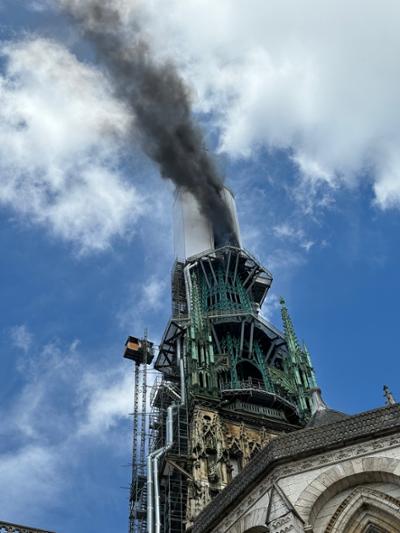

Risk planning, key to protecting cultural heritage
30% of fires in historic buildings are caused by hot work, as was the case at Notre-Dame de Paris Cathedral in Paris in 2019. According to TECNIFUEGO, risk planning, in addition to emergency management, is vital for protecting works of art and landmark sites. Safety managers must determine the main sources of danger, drawing up work rescue protocols and creating the resources necessary for the success of the plan.
A new fire recently affected a historic building, specifically the spire of the Gothic cathedral of Rouen, one of the architectural treasures of Normandy (France). Although the cause of the fire was initially unknown, the building had been undergoing construction work since 2016. The scene was reminiscent of two other events at iconic buildings, the devastating fire at Notre-Dame de Paris Cathedral in 2019, and the more latest one in April 2024 which destroyed much of the historic 17th-century Copenhagen Stock Exchange building.
TECNIFUEGO explains that the dramatic fire at Notre Dame marked a milestone worldwide in terms of safety measures for historic heritage undergoing construction. According to insurance companies, 30% of fires in these types of buildings are caused precisely by hot work, as was the case with the Paris cathedral.
Action protocols
Risk planning and emergency management form part of the process whereby the material to be protected are works of cultural interest: works of art or historical sites. Safety managers must determine the main sources of risk, drawing up work rescue protocols and creating the resources necessary for the success of the plan. An FPP (fire protection plan) must address the safeguarding of the building and its contents (works of art and objects of worship) in terms of three work stages: One is preventive, another involves extinguishing and rescue; and a third is for recovery.
At the preventive stage, a risk study needs to be carried out to correct the different situations that may generate danger, carefully inspecting the building, its facilities and whether there is sufficient maintenance. At the extinguishing and rescue stage, the fire-fighting systems installed and the work protocols come into play: how to proceed, development of a communication system etc. One of the most important decisions is the assignment of responsibilities and the creation of an operational chain that clearly determines who is the person in charge of making the initial decisions. Finally, the recovery stage focuses on establishing how to proceed in order to return to normality.
Early detection
Fire protection in cathedrals and temples of historical heritage interest must be undertaken in the same way as for a museum. It requires systems and elements developed specifically for their protection, extinguishing agents that are not harmful, but which are effective at extinguishing, fully ensuing that the works are cared for. Some of the most effective systems involve early fire detection, with connection to a fire alarm receiving centre that triggers programmed control functions, and the installation of automatic sprinklers in the false ceiling of the structure.
What’s more, it is essential to properly maintain the equipment and comply with the requirements set out in the Fire Protection Installation Regulations (RIPCI). For example, installation and maintenance companies must be duly qualified, have a quality management system certificate (ISO9001), carry out periodic maintenance, keep maintenance records, have a professional qualification card for operators to carry out maintenance work etc.





